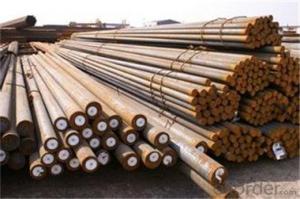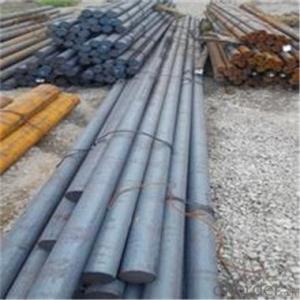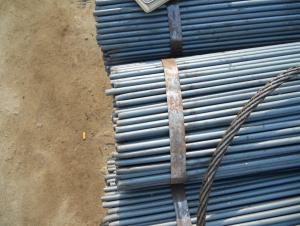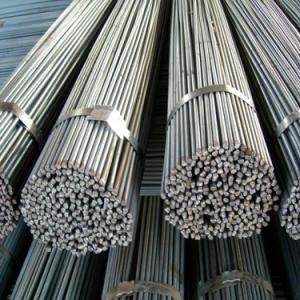Hard Chrome carbon Steel Round Bars from China
- Loading Port:
- Tianjin
- Payment Terms:
- TT OR LC
- Min Order Qty:
- 554 m.t.
- Supply Capability:
- 2000000 m.t./month
OKorder Service Pledge
OKorder Financial Service
You Might Also Like
Description of steel round bar:
1. Commodity: Round steel bar
3. Technical: Hot rolling
2. Length: Min. 5.8meter, according to requirement.
3. Diameter: 16mm-250mm
5. Packing: In Bundle or according to your requirements.
Festures of steel round bar:
1.Dia 80-800mm Length:2000-13000mm or as required
2.Technique:Forged Round Steel Bar Dia 80-800mm Length:2000-13000mm or as required
3.Delivery Time:45 days
Specifications of steel round bar:
1. Commodity: Round steel bar
3. Technical: Hot rolling
2. Length: Min. 5.8meter, according to requirement.
3. Diameter: 16mm-250mm
5. Packing: In Bundle or according to your requirements.
4. Standard: GB/T 3077-1999(42CrMo) ; JIS SCM440; DIN 42CrMo4 ; ASTM 4140 ; BS 708M40.sanitary wares,furniture handles,boiler,high temperature resistant,low temperature resistant, corrosion resistant.
Images of steel round bar:
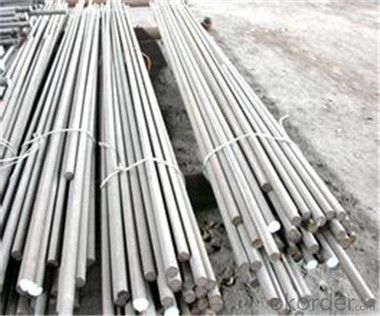
FAQ:
1. What is your main market?
We mainly export to Asia such as Japan,Korea,Thailand and North America and Middle East.
2. How long is the lead time?
Delivery time: 45 days after order confirmed.
- Q:How can steel round bars be protected from corrosion?
- Steel round bars can be protected from corrosion through various methods such as applying protective coatings like paint or epoxy, using galvanization or zinc coating, using corrosion inhibitors, or by implementing cathodic protection techniques such as sacrificial anodes or impressed current systems.
- Q:What are the advantages of using chromium-vanadium alloy steel round bars?
- There are several advantages of using chromium-vanadium alloy steel round bars: 1. High Strength: Chromium-vanadium alloy steel is known for its exceptional strength and hardness. It has a high tensile strength, making it suitable for applications that require heavy-duty performance and resistance to wear and tear. 2. Durability: The addition of chromium and vanadium elements enhances the durability of the alloy steel round bars. It provides excellent resistance to corrosion, oxidation, and high temperatures, making it ideal for use in harsh environments. 3. Versatility: Chromium-vanadium alloy steel round bars offer versatility in various applications. They can be used for manufacturing tools, springs, gears, and other components that require high strength and durability. The versatility of this alloy steel makes it a preferred choice in industries such as automotive, aerospace, and construction. 4. Machinability: Chromium-vanadium alloy steel is relatively easy to machine and work with, making it convenient for manufacturers. It can be easily shaped, cut, and formed into desired shapes and sizes without compromising its mechanical properties. 5. Cost-Effective: Despite its excellent properties, chromium-vanadium alloy steel round bars tend to be more cost-effective compared to other high-performance alloys. This makes it a popular choice for industries that require strong and durable materials without exceeding their budget. 6. Fatigue Resistance: Chromium-vanadium alloy steel exhibits exceptional fatigue resistance, making it suitable for applications that involve repetitive stress or cyclic loading. It can withstand repeated use and maintain its structural integrity over an extended period. Overall, chromium-vanadium alloy steel round bars offer a combination of high strength, durability, versatility, and cost-effectiveness. These advantages make it a preferred material choice for various industrial applications where reliability and performance are crucial.
- Q:How do you identify the grade of a steel round bar?
- There are several ways to determine the grade of a steel round bar. First, examining the markings or labels on the bar itself can provide valuable information. Manufacturers often imprint or etch the grade directly onto the bar's surface. These markings usually include details like the grade designation (e.g., 304, 316, 4140), which represents the specific alloy composition, and may also include additional information such as the heat or lot number. Another method involves consulting the mill test certificate (MTC) that comes with the steel round bar. The MTC provides extensive information about the composition, mechanical properties, and other relevant specifications of the material. Typically, the steel mill or supplier issues the MTC, and it can be requested at the time of purchase. Additionally, the grade of a steel round bar can be determined through visual inspection and physical testing. Visual inspection entails examining the bar's appearance, texture, and color. Different grades of steel exhibit distinct characteristics, such as a glossy or matte finish, specific surface treatments, or variations in color due to varying alloying elements. Physical testing methods, such as tensile or hardness testing, can further confirm the steel grade. These tests measure the material's mechanical properties, including its strength, ductility, and hardness. By comparing the test results with established standards and specifications for different steel grades, it is possible to identify the grade of the round bar. In conclusion, to ascertain the grade of a steel round bar, one can inspect the markings, refer to the mill test certificate, visually assess the bar, and conduct physical tests to evaluate its mechanical properties.
- Q:Are steel round bars recyclable?
- Yes, steel round bars are recyclable. Steel is one of the most commonly recycled materials in the world due to its high value and ease of recycling. When steel round bars reach the end of their useful life, they can be collected and sent to a recycling facility. At the recycling facility, the round bars are melted down and transformed into new steel products. This process can be repeated indefinitely without compromising the quality of the steel. Recycling steel round bars not only helps conserve natural resources and reduce waste but also saves energy and reduces greenhouse gas emissions compared to producing steel from raw materials.
- Q:What are the disadvantages of using steel round bars?
- There are several disadvantages of using steel round bars in certain applications. Firstly, steel round bars are relatively heavy compared to other materials such as aluminum or plastic. This can be a disadvantage when considering weight restrictions or when ease of transportation is important. Secondly, steel round bars are susceptible to corrosion, especially in environments with high moisture, humidity, or exposure to certain chemicals. This can lead to the degradation of the material over time, reducing its strength and durability. To mitigate this issue, additional precautions such as coatings or regular maintenance may be required, adding to the overall cost and effort. Furthermore, steel round bars may not be suitable for applications where electrical conductivity is a concern. Steel is a good conductor of electricity, which can be a disadvantage in situations where electrical insulation is necessary. Lastly, steel round bars may not be as aesthetically pleasing as materials like wood or decorative metals. While this may not be a significant disadvantage in certain applications, it can be a drawback in situations where the visual appearance is important, such as architectural or interior design projects. Overall, while steel round bars are widely used and offer numerous advantages such as high strength and durability, it is important to consider these disadvantages in specific applications to ensure the optimal choice of materials.
- Q:What are the advantages of using nickel-chromium-manganese alloy steel round bars?
- Nickel-chromium-manganese alloy steel round bars offer numerous benefits in various applications. Firstly, this type of alloy steel provides exceptional strength and durability. The combination of nickel, chromium, and manganese enhances the overall strength of the steel, making it resistant to wear, impact, and deformation. This is particularly advantageous in industries such as construction, manufacturing, and automotive, where the round bars are commonly used for structural support and load-bearing purposes. Secondly, the round bars made from nickel-chromium-manganese alloy steel exhibit outstanding corrosion resistance. The presence of nickel and chromium in the alloy composition results in high resistance to rust and oxidation, even in harsh environments or exposure to corrosive substances. This property is crucial in applications where the round bars are exposed to moisture, chemicals, or high temperatures, such as marine environments or chemical processing plants. Additionally, this type of alloy steel offers excellent weldability and machinability. The balanced composition of nickel, chromium, and manganese enables easy welding and machining operations. This convenience allows fabricators and manufacturers to work with the round bars, creating complex shapes or structures without compromising the material's integrity. Moreover, nickel-chromium-manganese alloy steel round bars possess exceptional heat resistance. The presence of nickel and chromium in the alloy composition enhances its ability to withstand high temperatures without losing strength or shape. This property makes it suitable for applications involving exposure to extreme heat, such as furnace components, heat exchangers, or high-temperature industrial processes. Lastly, the use of nickel-chromium-manganese alloy steel round bars often leads to long-term cost savings. Due to their remarkable strength and durability, these round bars have a longer lifespan compared to other materials. This reduces the need for frequent replacements, resulting in lower maintenance costs and improved overall efficiency. In conclusion, the advantages of nickel-chromium-manganese alloy steel round bars include remarkable strength and durability, corrosion resistance, weldability, machinability, heat resistance, and long-term cost savings. These properties make them a preferred choice in various industries that require high-performance materials.
- Q:What is the difference between a rough turned and a centerless ground steel round bar?
- A rough turned steel round bar is a type of steel bar that has been partially machined to remove excess material and create a rough surface finish. It undergoes a turning process on a lathe, which removes the outer layer of the steel bar to achieve a specific diameter and shape. On the other hand, a centerless ground steel round bar is a type of steel bar that has undergone a precise grinding process to achieve a smooth and polished finish. This process involves feeding the steel bar through a centerless grinder, which removes any imperfections or irregularities on the outer surface, resulting in a consistently smooth and uniform diameter. In summary, the main difference between a rough turned and a centerless ground steel round bar lies in the level of surface finish and precision. Rough turned bars have a rougher surface finish and are not as precisely sized as centerless ground bars, which have a smooth, polished finish and are manufactured with tighter tolerances.
- Q:What are the different types of steel round bars used in the manufacturing of bearings?
- The manufacturing of bearings involves the use of various types of steel round bars. The choice of steel depends on factors like the application, load capacity, and desired performance of the bearing. One popular option is through-hardened steel, which undergoes heat treatment to achieve consistent hardness throughout the bar. These round bars offer excellent strength and wear resistance, making them suitable for heavy-duty bearing applications. Another commonly used steel is case-hardened steel. In this case, the surface is hardened while the core remains relatively soft. This combination provides high surface hardness for wear resistance, as well as improved toughness and impact resistance. Stainless steel is another steel type utilized in bearing production, especially in environments where corrosion resistance is required. Stainless steel round bars have exceptional resistance to rust and corrosion, making them ideal for marine or chemical industries. Additionally, alloy steel round bars are commonly employed in bearing manufacturing. These steels are created by adding alloying elements like chromium, molybdenum, or nickel to enhance specific properties such as hardness, toughness, or heat resistance. Alloy steel round bars are often used in specialized bearing applications that require exceptional performance under high temperatures or extreme conditions. To summarize, the manufacturing of bearings involves different types of steel round bars, including through-hardened steel, case-hardened steel, stainless steel, and alloy steel. Each type offers unique properties and characteristics that make them suitable for specific bearing applications.
- Q:What is the difference between a polished and a cold drawn steel round bar?
- A polished steel round bar refers to a steel bar that has undergone a polishing process, which involves using abrasive materials to remove any surface imperfections and create a smooth, shiny finish. Polishing enhances the aesthetic appearance of the steel bar and improves its corrosion resistance. This process is commonly used for decorative or architectural applications where the visual appeal is important. On the other hand, a cold drawn steel round bar is produced through a different manufacturing process. In this method, a steel bar is pulled through a die at room temperature to reduce its diameter and increase its length. This process results in a bar with a more precise and uniform diameter, as well as improved mechanical properties such as higher tensile strength and dimensional accuracy. Cold drawing also enhances the surface finish, but it may not achieve the same level of smoothness and shine as a polished bar. In summary, the main difference between a polished and a cold drawn steel round bar lies in the manufacturing process and the resulting properties. Polishing provides a smooth and shiny finish for aesthetic purposes, while cold drawing improves the dimensional accuracy and mechanical properties of the steel bar.
- Q:What is the typical yield strength of a steel round bar?
- The typical yield strength of a steel round bar can vary depending on the specific grade and manufacturing process, but it is commonly in the range of 300 to 700 megapascals (MPa).
1. Manufacturer Overview |
|
|---|---|
| Location | |
| Year Established | |
| Annual Output Value | |
| Main Markets | |
| Company Certifications | |
2. Manufacturer Certificates |
|
|---|---|
| a) Certification Name | |
| Range | |
| Reference | |
| Validity Period | |
3. Manufacturer Capability |
|
|---|---|
| a)Trade Capacity | |
| Nearest Port | |
| Export Percentage | |
| No.of Employees in Trade Department | |
| Language Spoken: | |
| b)Factory Information | |
| Factory Size: | |
| No. of Production Lines | |
| Contract Manufacturing | |
| Product Price Range | |
Send your message to us
Hard Chrome carbon Steel Round Bars from China
- Loading Port:
- Tianjin
- Payment Terms:
- TT OR LC
- Min Order Qty:
- 554 m.t.
- Supply Capability:
- 2000000 m.t./month
OKorder Service Pledge
OKorder Financial Service
Similar products
New products
Hot products
Related keywords
